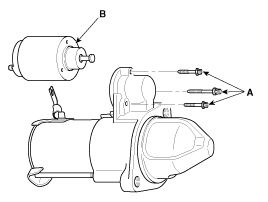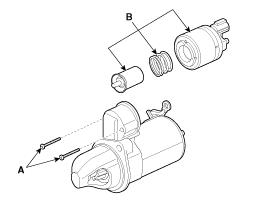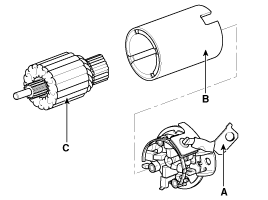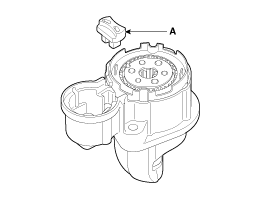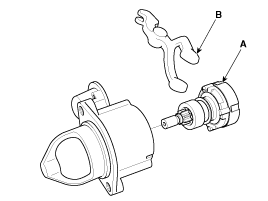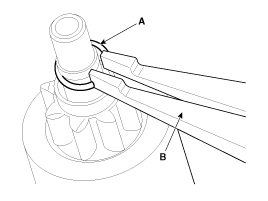 Hyundai Sonata: Starter. Repair procedures
Hyundai Sonata: Starter. Repair procedures
Removal and Installation
| 1. |
Remove the engine cover.
|
| 2. |
Disconnect the battery negative terminal (A).
|
| 3. |
Remove the air duct (B).
|
| 4. |
Remove the air cleaner assembly.
|
| 5. |
Remove the ETC (Electronic throttle control) module (A) and MAPS
(Manifold absolute pressure sensor & IATS (Intake air temperature sensor)
(B).
|
| 6. |
Remove the intake manifold stay (A).
|
| 7. |
Disconnect the starter cable (A) from the B terminal on the solenoid,
then disconnect the connector (B) from the S terminal.
|
| 8. |
Remove the 2 bolts (C) holding the starter, then remove the starter.
|
| 9. |
Installation is the reverse of removal.
|
Disassembly
| 1. |
Disconnect the M-terminal (A) on the magnet switch assembly (B).
[REMY]
[VALEO]
|
| 2. |
After loosening the screws (A), detach the magnet switch assembly
(B).
[REMY]
[VALEO]
|
| 3. |
Loosen the through bolts (A).
[REMY]
[VALEO]
|
| 4. |
Remove the brush holder assembly (A), yoke (B) and armature (C).
[REMY]
[VALEO]
|
| 5. |
REMY : Remove the lever plate (B) and lever packing (A).
VALEO : Remove the lever stop (A).
|
| 6. |
Remove the packing (A) and shield (B). (REMY only)
|
| 7. |
Disconnect the planet gear (A). (REMY only)
|
| 8. |
Disconnect the planet shaft assembly (or reducer assembly) (A)
and lever (B).
[REMY]
[VALEO]
|
| 9. |
Press the stopper (A) using a socket (B).
|
| 10. |
After removing the stop ring (A) using stop ring pliers (B).
|
| 11. |
Disconnect the stopper (A), overrunning clutch (B), internal gear
(C), planet shaft (or drive shaft) (D) and/or gasket sheet (E).
[REMY]
[VALEO]
|
| 12. |
Reassembly is the reverse of disassembly.
|
Inspection
| Armature Inspection And Test |
| 1. |
Remove the starter.
|
| 2. |
Disassemble the starter as shown at the beginning of this procedure.
|
| 3. |
Inspect the armature for wear or damage from contact with the
permanent magnet. If there is wear or damage, replace the armature.
|
| 4. |
Check the commutator (A) surface. If the surface is dirty or burnt,
resurface with emery cloth or a lathe within the following specifications,
or recondition with #500 or #600 sandpaper (B).
|
| 5. |
Measure the commutator (A) runout.
|
| 6. |
Check the mica depth (A). If the mica is too high (B), undercut
the mica with a hacksaw blade to the proper depth. Cut away all the
mica (C) between the commutator segments. The undercut should not be
too shallow, too narrow, or v-shaped (D).
|
| 7. |
Check for continuity between the segments of the commutator. If
an open circuit exists between any segments, replace the armature.
|
| 8. |
Check with an ohmmeter that no continuity exists between the commutator
(A) and armature coil core (B), and between the commutator and armature
shaft (C). If continuity exists, replace the armature.
|
Inspect Starter Brush
Brushes that are worm out, or oil-soaked, should be replaced.
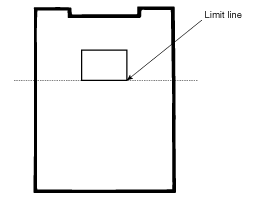
Starter Brush Holder Test
Check that there is no continuity between the (+) brush holder (A) and
(-) plate (B). If there is continuity, replace the brush holder assembly.

Inspect Overrunning Clutch
| 1. |
Slide the overrunning clutch along the shaft.
Replace it if does not slide smoothly.
|
| 2. |
Rotate the overrunning clutch both ways.
Does it lock in one direction and rotate smoothly in reverse?
If it does not lock in either direction or it locks in both directions,
replace it.
|
| 3. |
If the starter drive gear is worn or damaged, replace the overrunning
clutch assembly. (the gear is not available separately).
Check the condition of the flywheel or torque converter ring gear
if the starter drive gear teeth are damaged.
|
Cleaning
| 1. |
Do not immerse parts in cleaning solvent. Immersing the yoke assembly
and/or armature will damage the insulation. Wipe these parts with a
cloth only.
|
| 2. |
Do not immerse the drive unit in cleaning solvent. The overrun
clutch is pre-lubricated at the factory and solvent will wash lubrication
from the clutch.
|
| 3. |
The drive unit may be cleaned with a brush moistened with cleaning
solvent and wiped dry with a cloth.
|
 Starter. Components and Components Location
Starter. Components and Components Location
Components
[REMY]
1. Front bracket
2. Stop ring
3. Stopper
4. Overrun clutch assembly
5. Internal gear assembly
6. Lever
7. Lever packing
8. Magnet s ...
 Starter Relay. Repair procedures
Starter Relay. Repair procedures
Inspection
1.
Remove the fuse box cover.
2.
Remove the starter relay (A).
3.
Using an ohmmeter, check ...
See also:
Tire and loading information label
The label located on the driver's door sill gives the original tire size, cold
tire pressures recommended for your vehicle, the number of people that can be in
your vehicle and veh ...
CVVT Oil Control Valve (OCV). Repair procedures
Inspection
1.
Turn the ignition switch OFF.
2.
Disconnect the OCV connector.
3.
Measure resistance between the ...
Heated Oxygen Sensor (HO2S). Schematic Diagrams
Circuit Diagram
...








